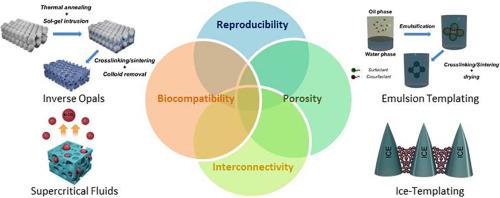Advances in Colloid and Interface Science ( IF 15.9 ) Pub Date : 2020-08-08 , DOI: 10.1016/j.cis.2020.102237 Christian Vila-Parrondo 1 , Clara García-Astrain 1 , Luis M Liz-Marzán 2

|
Three-dimensional porous scaffolds are essential for the development of tissue engineering and regeneration, as biomimetic supports to recreate the microenvironment present in natural tissues. To successfully achieve the growth and development of a specific kind of tissue, porous matrices should be able to influence cell behavior by promoting close cell-cell and cell-matrix interactions. To achieve this goal, the scaffold must fulfil a set of conditions, including ordered interconnected porosity to promote cell diffusion and vascularization, mechanical strength to support the tissue during continuous ingrowth, and biocompatibility to avoid toxicity. Among various building approaches to the construction of porous matrices, selected strategies afford hierarchical scaffolds with such defined properties. The control over porosity, microstructure or morphology, is crucial to the fabrication of high-end, reproducible scaffolds for the target application. In this review, we provide an insight into recent advances toward the colloidal fabrication of hierarchical scaffolds. After identifying the main requirements for scaffolds in biomedical applications, conceptual building processes are introduced. Examples of tissue regeneration applications are provided for different scaffold types, highlighting their versatility and biocompatibility. We finally provide a prospect about the current state of the art and limitations of porous scaffolds, along with challenges that are to be addressed, so these materials consolidate in the fields of tissue engineering and drug delivery.
中文翻译:

面向3D细胞培养支架的胶体系统。
三维多孔支架对于组织工程的发展和再生至关重要,因为仿生载体可以重建天然组织中存在的微环境。为了成功实现特定类型组织的生长和发育,多孔基质应能够通过促进紧密的细胞-细胞和细胞-基质相互作用来影响细胞行为。为了实现该目标,支架必须满足一系列条件,包括有序的相互连接的孔隙度以促进细胞扩散和血管形成,在连续向内生长期间支持组织的机械强度,以及避免毒性的生物相容性。在用于构建多孔基质的各种构建方法中,所选择的策略提供具有这种定义的特性的分级支架。对孔隙的控制,微观结构或形态对于目标应用的高端可复制支架的制造至关重要。在这篇综述中,我们提供了对分层支架胶体制造的最新进展的见解。在确定生物医学应用中对支架的主要要求后,介绍了概念性构建过程。提供了针对不同支架类型的组织再生应用的示例,突出了它们的多功能性和生物相容性。最后,我们提供了有关多孔支架的最新技术和局限性的前景,以及需要解决的挑战,因此这些材料在组织工程和药物输送领域得到了巩固。在这篇综述中,我们提供了对分层支架胶体制造的最新进展的见解。在确定生物医学应用中对支架的主要要求后,介绍了概念性构建过程。提供了针对不同支架类型的组织再生应用的示例,突出了它们的多功能性和生物相容性。最后,我们提供了有关多孔支架的最新技术和局限性的前景,以及需要解决的挑战,因此这些材料在组织工程和药物输送领域得到了巩固。在这篇综述中,我们提供了对分层支架胶体制造的最新进展的见解。在确定生物医学应用中对支架的主要要求后,介绍了概念性构建过程。提供了针对不同支架类型的组织再生应用的示例,突出了它们的多功能性和生物相容性。最后,我们提供了有关多孔支架的最新技术和局限性的前景,以及需要解决的挑战,因此这些材料在组织工程和药物输送领域得到了巩固。介绍了概念构建过程。提供了针对不同支架类型的组织再生应用的示例,突出了它们的多功能性和生物相容性。最后,我们提供了有关多孔支架的最新技术和局限性的前景,以及需要解决的挑战,因此这些材料在组织工程和药物输送领域得到了巩固。介绍了概念构建过程。提供了针对不同支架类型的组织再生应用的示例,突出了它们的多功能性和生物相容性。最后,我们提供了有关多孔支架的最新技术和局限性的前景,以及需要解决的挑战,因此这些材料在组织工程和药物输送领域得到了巩固。











































 京公网安备 11010802027423号
京公网安备 11010802027423号